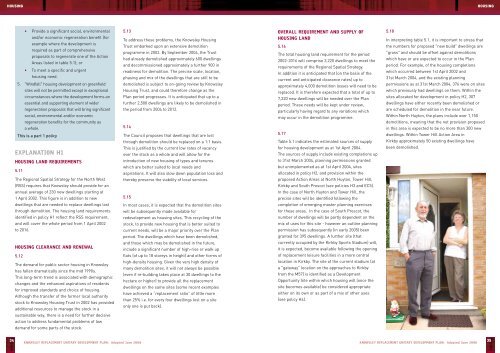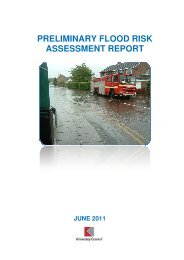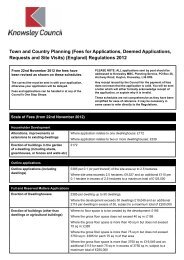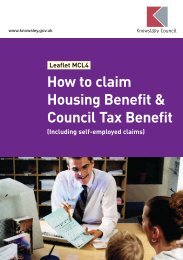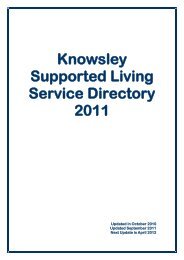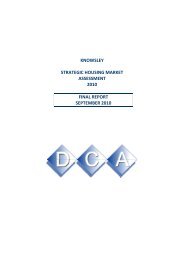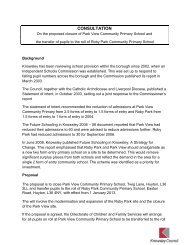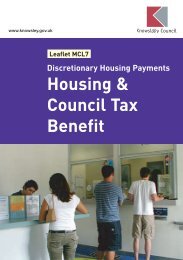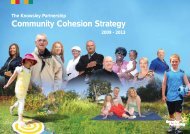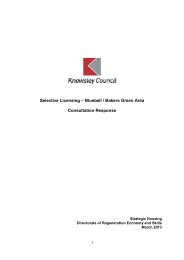Knowsley Replacement Unitary Development Plan - Knowsley Council
Knowsley Replacement Unitary Development Plan - Knowsley Council
Knowsley Replacement Unitary Development Plan - Knowsley Council
You also want an ePaper? Increase the reach of your titles
YUMPU automatically turns print PDFs into web optimized ePapers that Google loves.
HOUSING<br />
HOUSING<br />
• Provide a significant social, environmental<br />
and/or economic regeneration benefit (for<br />
example where the development is<br />
required as part of comprehensive<br />
proposals to regenerate one of the Action<br />
Areas listed in table 5.1); or<br />
• To meet a specific and urgent<br />
housing need.<br />
5. "Windfall" housing development on greenfield<br />
sites will not be permitted except in exceptional<br />
circumstances where the development forms an<br />
essential and supporting element of wider<br />
regeneration proposals that will bring significant<br />
social, environmental and/or economic<br />
regeneration benefits for the community as<br />
a whole.<br />
This is a part 1 policy<br />
EXPLANATION H1<br />
HOUSING LAND REQUIREMENTS<br />
5.11<br />
The Regional Spatial Strategy for the North West<br />
(RSS) requires that <strong>Knowsley</strong> should provide for an<br />
annual average of 230 new dwellings starting at<br />
1 April 2002. This figure is in addition to new<br />
dwellings that are needed to replace dwellings lost<br />
through demolition. The housing land requirements<br />
identified in policy H1 reflect the RSS requirement,<br />
and will cover the whole period from 1 April 2002<br />
to 2016.<br />
HOUSING CLEARANCE AND RENEWAL<br />
5.12<br />
The demand for public sector housing in <strong>Knowsley</strong><br />
has fallen dramatically since the mid 1990s.<br />
This long-term trend is associated with demographic<br />
changes and the enhanced aspirations of residents<br />
for improved standards and choice of housing.<br />
Although the transfer of the former local authority<br />
stock to <strong>Knowsley</strong> Housing Trust in 2002 has provided<br />
additional resources to manage the stock in a<br />
sustainable way, there is a need for further decisive<br />
action to address fundamental problems of low<br />
demand for some parts of the stock.<br />
5.13<br />
To address these problems, the <strong>Knowsley</strong> Housing<br />
Trust embarked upon an extensive demolition<br />
programme in 2002. By September 2004, the Trust<br />
had already demolished approximately 600 dwellings<br />
and decommissioned approximately a further 900 in<br />
readiness for demolition. The precise scale, location,<br />
phasing and mix of the dwellings that are still to be<br />
demolished is subject to on-going review by <strong>Knowsley</strong><br />
Housing Trust, and could therefore change as the<br />
<strong>Plan</strong> period progresses. It is anticipated that up to a<br />
further 2,500 dwellings are likely to be demolished in<br />
the period from 2004 to 2012.<br />
5.14<br />
The <strong>Council</strong> proposes that dwellings that are lost<br />
through demolition should be replaced on a 1:1 basis.<br />
This is justified by the current low rates of vacancy<br />
over the stock as a whole and will allow for the<br />
introduction of new housing of types and tenures<br />
which are better suited to local needs and<br />
aspirations. It will also slow down population loss and<br />
thereby preserve the viability of local services.<br />
5.15<br />
In most cases, it is expected that the demolition sites<br />
will be subsequently made available for<br />
redevelopment as housing sites. This recycling of the<br />
stock, to provide new housing that is better suited to<br />
current needs, will be a major priority over the <strong>Plan</strong><br />
period. The dwellings which have been demolished,<br />
and those which may be demolished in the future,<br />
include a significant number of high-rise or walk up<br />
flats (of up to 18 storeys in height) and other forms of<br />
high-density housing. Given the very high density of<br />
many demolition sites, it will not always be possible<br />
(even if re-building takes place at 30 dwellings to the<br />
hectare or higher) to provide all the replacement<br />
dwellings on the same sites (some recent examples<br />
have achieved a “replacement ratio” of little more<br />
than 25% i.e. for every four dwellings lost on a site<br />
only one is put back).<br />
OVERALL REQUIREMENT AND SUPPLY OF<br />
HOUSING LAND<br />
5.16<br />
The total housing land requirement for the period<br />
2002-2016 will comprise 3,220 dwellings to meet the<br />
requirements of the Regional Spatial Strategy.<br />
In addition it is anticipated that (on the basis of the<br />
current and anticipated clearance rates) up to<br />
approximately 4,000 demolition losses will need to be<br />
replaced. It is therefore expected that a total of up to<br />
7,220 new dwellings will be needed over the <strong>Plan</strong><br />
period. These needs will be kept under review,<br />
particularly having regard to any variations which<br />
may occur in the demolition programme.<br />
5.17<br />
Table 5.1 indicates the estimated sources of supply<br />
for housing development as at 1st April 2004.<br />
The sources of supply include existing completions up<br />
to 31st March 2004, planning permissions granted<br />
but unimplemented as at 1st April 2004, sites<br />
allocated in policy H2, and provision within the<br />
proposed Action Areas at North Huyton, Tower Hill,<br />
Kirkby and South Prescot (see policies H3 and EC5).<br />
In the case of North Huyton and Tower Hill, the<br />
precise sites will be identified following the<br />
completion of emerging master planning exercises<br />
for these areas. In the case of South Prescot, the<br />
number of dwellings will be partly dependent on the<br />
mix of uses for this site - however an outline planning<br />
permission has subsequently (in early 2005) been<br />
granted for 395 dwellings. A further site (that<br />
currently occupied by the Kirkby Sports Stadium) will,<br />
it is expected, become available following the opening<br />
of replacement leisure facilities in a more central<br />
location in Kirkby. The site of the current stadium (at<br />
a "gateway" location on the approaches to Kirkby<br />
from the M57) is identified as a <strong>Development</strong><br />
Opportunity Site within which housing will (once the<br />
site becomes available) be considered appropriate<br />
either on its own or as part of a mix of other uses<br />
(see policy H4).<br />
5.18<br />
In interpreting table 5.1, it is important to stress that<br />
the numbers for proposed "new build" dwellings are<br />
"gross" and should be offset against demolitions<br />
which have or are expected to occur in the <strong>Plan</strong><br />
period. For example, of the housing completions<br />
which occurred between 1st April 2002 and<br />
31st March 2004, and the existing planning<br />
permissions as at 31st March 2004, 376 were on sites<br />
which previously had dwellings on them. Within the<br />
sites allocated for development in policy H2, 307<br />
dwellings have either recently been demolished or<br />
are scheduled for demolition in the near future.<br />
Within North Huyton, the plans include over 1,150<br />
demolitions, meaning that the net provision proposed<br />
in this area is expected to be no more than 300 new<br />
dwellings. Within Tower Hill Action Area in<br />
Kirkby approximately 50 existing dwellings have<br />
been demolished.<br />
34<br />
KNOWSLEY REPLACEMENT UNITARY DEVELOPMENT PLAN: Adopted June 2006<br />
KNOWSLEY REPLACEMENT UNITARY DEVELOPMENT PLAN: Adopted June 2006<br />
35


